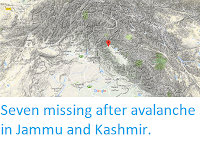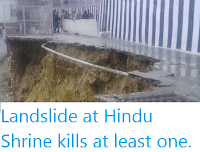A nine-year-old-girl has died and three of her relatives have been injured in the Rajouri District of Jammu and Kashmir, India, on Saturday 3 November 2018. Shabina Kousar was a member of a group of nomadic Bakarwal people, who had set up a tent encampment close to a shrine in the village of Chatyar, as part of an annual migration between summer grazing grounds in the high mountains of the region and winter grazing grounds in the lowlands.
The approximate location of the 3 November 2018 Rajouri District landslide. Google Maps.
The incident occurred during a series of thunderstorms which swept across Jammu and Kashmir over the past three days. Thunderstorms
occur when warm, moist bodies of air encounter cooler, drier air
packages. The warm air rises over the cooler air until it rises above
its dew point (the point where it cools to far to retain its water
content as vapour), and the water precipitates out, falling as rain,
sleet or hail.
In a separate incident a villager was killed and two relatives injured by a lightning strike in Reasi District. Warm
moist air passing over the surface of the Earth acts as an electrical
generator, creating a negative charge in the cloud tops and a positive
charge at the ground (or occasionally in a second cloud layer). The
atmosphere acts as an electrical insulator, allowing this potential to
build up, until water begins to precipitate out. This allows a channel
of ionised air to form, carrying a current between the clouds and the
ground, which we perceive as lightning.
See also...
Follow Sciency Thoughts on Facebook.







